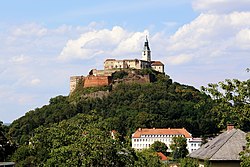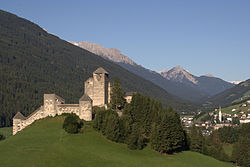| Griffen Castle | |
|---|---|
| Griffen, Austria | |
 | |
| Site information | |
| Type | Castle |
| Owner | Market Town of Griffen |
| Open to the public | yes |
| Condition | ruins |
| Location | |
 | |
| Coordinates | 46°42′19″N14°43′39″E / 46.70528°N 14.72750°E |
| Site history | |
| Built | 1124-1146 |
| Built by | Otto of Bamberg |
| In use | until 1768 |
| Demolished | 1840 |
| Battles/wars | 1292-1293 occupied by Count Ulrich von Heunberg |
The Burg Griffen is a castle on a 130m/427 ft-high limestone mountain above the town of Griffen in the Austrian state of Carinthia. [1]








